By Eric Vandenbroeck and co-workers
Where earlier we argued that if Homo sapiens somehow could have found a
way to coexist with T. rex, it is unclear which would have become the more intelligent and dominant
species. In some regions, growth-enhancing geography and diversity led to
the rapid adaptation of cultural traits and institutional features to their
surroundings, and the acceleration of technological progress. Centuries later,
this process triggered an outburst of demand for human capital, a sudden drop
in birth rates, and thus an earlier transition to the modern era of growth.
What happend because humans 'did 'survive
whereby for most of this period, successful adaptation generated
progressively better hunters and gatherers, which enabled a rise in the food
supply and a significant increase in the size of the human population.
Eventually, living space and natural resources available per person declined,
and sometimes as early as 60,000 to 90,000 years ago, Homo sapiens embarked on
a large-scale exodus out of the African continent in search of additional
fertile living grounds. Due to the serial nature of this migratory process, it
was inherently associated with a reduction in the diversity of populations that
settled at greater migratory distances from Africa; the further away from
Africa humans moved, the lower the degree of cultural, linguistic, behavioral,
and physical diversity in their societies.
This phenomenon reflects the serial founder effect. Imagine an island
that is home to five main breeds of parrot – blue, yellow, black, green, and
red – equally well adapted for survival on this island. When the island is hit
by a typhoon, a few parrots have swept away to a deserted, far-flung isle. This
small subgroup is unlikely to contain parrots from all five of the original
breeds. These parrots might be mostly red, yellow, and blue, for instance, and
their chicks – which will soon fill the new island – will inherit their colors.
The colony that will develop on the new island will therefore be less diverse
than the original population. If a very small flock of parrots then migrates
from the second island to a third, that group is likely to be even less diverse
than those in each of the previous colonies. Thus, as long as the parrots
migrate from each parental island more rapidly than the pace of potential
mutations on the island, the further away the parrots migrate (sequentially)
from the original island, the less diverse their population will be.
Human migration out of Africa followed a comparable pattern. An initial
group left Africa and settled in fertile regions nearby, carrying only a subset
of the diversity that existed in their parental African population. Once the
initial migratory group had grown to the extent that its new environment could
no longer support any additional expansion, a less diverse subgroup departed in
search of other virgin territory and settled in habitats further away. During
this human dispersal out of Africa and the peopling of the continents, this
process repeated itself: as populations grew, new subgroups containing only
some of the diversity in their parental colony left again in a quest for
greener pastures. Although some groups switched course, as will become
apparent, the thrust of these migratory patterns was such that groups who left
Africa and reached Western Asia were less diverse than the original human
population in Africa, and their descendants who continued migrating east to
Central Asia and ultimately to Oceania and the Americas, or north-west to
Europe were progressively even less diverse than those who remained behind.
This expansion of anatomically modern humans from the cradle of humankind in Africa
has imparted a deep and indelible mark on the worldwide variation in the degree
of diversity – cultural, linguistic, behavioral, and physical – across
populations This decline in the overall level of population diversity with
migratory distance from Africa is partly reflected in the reduction in genetic
diversity among indigenous ethnic groups at a greater migratory distance from
Africa. Based on a comparable measure of this type of diversity for 267
distinct populations, most of which can be associated with specific indigenous
ethnic groups and their geographical homeland, it is apparent that the most
diverse indigenous ethnic groups are those closest to East Africa, whereas the
least diverse are the indigenous communities of Central and South America,
whose overland migratory distance from Africa is the longest.
This negative correlation between diversity and migratory distance from
East Africa is a pattern that is observed not only across continents. It is
present within continents as well.
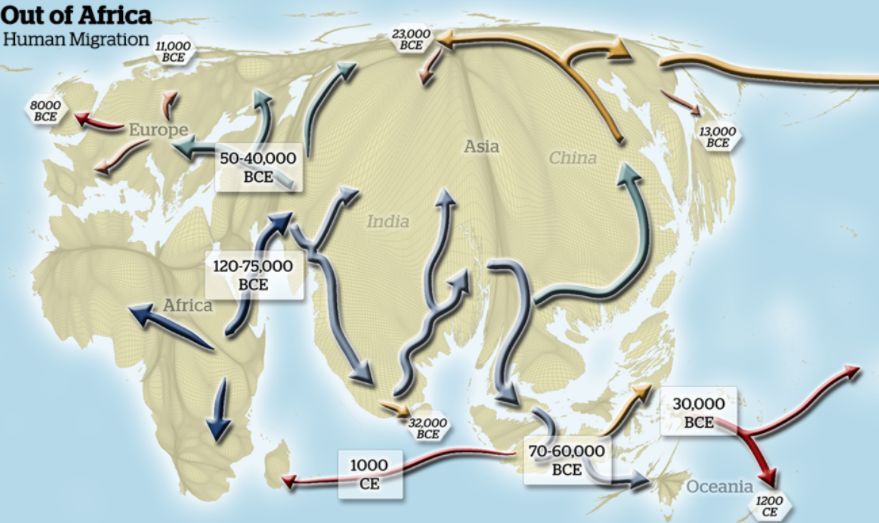
Broader evidence for the diminishing levels of diversity among
indigenous groups at a greater migratory distance from Africa comes from the
fields of physical and cognitive anthropology. Studies of particular features
of body shape – for example, the bone structure pertaining to particular dental
attributes, pelvic traits and the shape of the birth canal – as well as
cultural distinctions, such as the differences between the fundamental units of
speech (‘phonemes’) in different languages, also confirm the existence of a
serial founder effect originating in East Africa; again, the greater the
migratory distance from East Africa, the lower the diversity in these physical
and cultural characteristics. Of course, a proper exploration of the impact of
the overall level of population diversity in all its multifaceted forms on the
economic prosperity of nations would require a far more comprehensive measure
than geneticists and anthropologists provide. In addition, it would need to be
independent of the population’s degree of economic development so as to be used
to assess the causal effect of diversity on the wealth of nations. What might
such a measure look like?
Migratory Distance from East Africa and Diversity among Geographically
Indigenous Ethnic Groups:
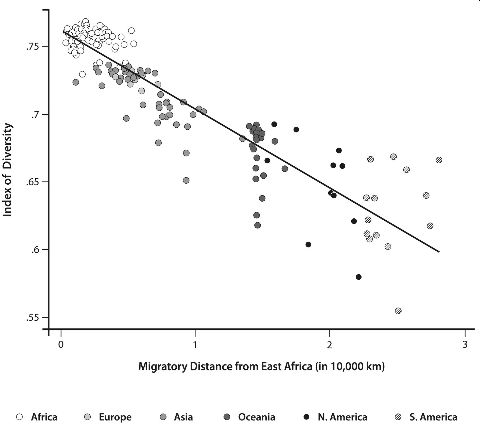
Conventional measures of population diversity tend to capture only the
proportional representation of the ethnic or linguistic groups in a population.
These measures suffer therefore from two major deficiencies. One is that some
ethnic and linguistic groups are more closely related than others. A society
that consists of an equal proportion of Danish people and Swedish people may
not be as diverse as a society that is composed of equal fractions of Danish
and Japanese. The other is that ethnic and linguistic groups are not internally
homogenous. A nation composed entirely of Japanese people would not necessarily
be as diverse as a nation composed entirely of Danish people. In fact,
diversity within an ethnic group is typically an order of magnitude larger than
the diversity between groups.
A comprehensive measure of the overall diversity of a national
population ought therefore to capture at least two additional aspects of
diversity. First, diversity within each ethnic or subnational group, such as
within the Irish or the Scottish population in the US. Second, the degree of
diversity between any pair of ethnic or subnational groups, capturing, for
example, the relative cultural proximity of the Irish and Scottish populations
of the US in comparison to its Irish and Mexican populations.
In view of the tight negative correlation between migratory distance
from East Africa and diversity in observable traits, these migratory distances
can be used as a proxy for the historical level of diversity in each
geographical location on Planet Earth. We can therefore construct an index of
predicted overall diversity for each national population today, based on the
migratory distance from Africa of their ancestral populations, taking into
account (the relative size of each ancestral subgroup within the country;
the diversity of each of these subgroups as predicted by the distance that their
ancestors traveled over the course of their migration from East Africa; and
(iii) the degree of pairwise diversity between each of these subgroups, as
predicted by the migratory distances between the geographical homelands of the
ancestral populations of each pair.
This statistical measure of predicted diversity has two major virtues.
First, prehistorical migratory distance from East Africa is clearly independent
of current levels of economic prosperity and thus the measure permits the
estimation of the causal effect of diversity on living standards. Second, as
highlighted above, mounting evidence from the fields of physical and cognitive
anthropology suggests that migratory distance from Africa has had an important
effect on diversity in a range of traits that are expressed physically and behaviourally; reassuringly, therefore, the kind of
diversity our measure predicts could affect societal outcomes. Moreover, if the
index measures diversity inaccurately (in a random fashion) – because of a
failure to properly account for internal migration within each of the
continents, for example – statistical theory suggests that this would tend to
lead us to reject, rather than to confirm, the hypothesized impact of diversity
on economic prosperity. In other words, if we are erring, we are erring on the
side of caution.
Finally, it is important to clarify that our measure of diversity is a
societal characteristic. It measures the breadth of variety of human traits
within society regardless of what those traits are or how they may differ
between societies. It, therefore, does not and cannot be used to imply that
some traits are more conducive than others for economic success. Rather, it
captures the potential impact of the diversity in human traits, within a
society, on economic prosperity. In fact, accounting for confounding
geographical and historical factors, it appears that migratory distance from
Africa per se has no impact on the average level of traits such as height and
weight across the globe. It predominantly affects the extent of the deviation
of individuals in the population from this average level.
Armed with this powerful measure of the overall diversity of each
population, we can, at last, explore whether the exodus out of Africa that
occurred tens of thousands of years ago and its impact on human diversity,
might have had an astoundingly long-lasting effect on current living standards
across the globe.
Diversity and Prosperity
Living conditions in the course of history have indeed been influenced
significantly by levels of diversity and therefore by the migration of Homo
sapiens out of Africa. Migratory distances of the ancestral populations of each
country, or ethnic group, from the cradle of humankind in East Africa, have
generated a persistent ‘hump-shaped’ influence on development outcomes,
reflecting a fundamental trade-off between the beneficial and the detrimental
effects of diversity on productivity at the societal level.
This ‘hump-shaped’ effect of diversity on economic productivity,
whether captured by past levels of population density or urbanization rates, or
current levels of per capita income or night-light intensity (based on
satellite imagery), is both stark and consistent across countries and ethnic
groups. Moreover, these hump-shaped patterns remain qualitatively unchanged
over the 12,000 years since the Neolithic Revolution. Thus, in the absence of
policies that mitigate the cost of diversity in heterogeneous nations and
enhance the level of diversity in homogenous ones, intermediate levels of diversity
have been most conducive to economic prosperity.
In fact, this hump-shaped effect is unique to the impact of ancestral
migratory distance from Africa. Alternative distances, unrelated to the exodus
of Homo sapiens from Africa and to human diversity, do not generate similar
hump-shaped patterns. In particular, aerial distance from East Africa, as
opposed to migratory distance, is uncorrelated with economic prosperity, which
is reassuring, since prehistoric humans migrated out of Africa by foot rather
than by airplane. Furthermore, migratory distances from ‘placebo origins’ –
other focal points on Planet Earth from which Homo sapiens has clearly not
emerged – London, Tokyo, or Mexico City – do not have any effect on economic
prosperity. Nor is this relationship-driven by geographic proximity to leading
technological frontiers in the distant past, such as the Fertile Crescent.
Separate bodies of evidence confirm the proposed mechanism behind this
intriguing result: namely, that societal diversity has indeed exerted
conflicting effects on economic well-being. On the one hand, by widening the
spectrum of individual values, beliefs, and preferences in social interactions,
the findings suggest that diversity has diminished interpersonal trust, eroded
social cohesion, increased the incidence of civil conflicts, and introduced
inefficiencies in the provision of public goods, thus adversely affecting
economic performance.[16] On the other hand, greater societal diversity has
fostered economic development by widening the spectrum of individual traits,
such as skills and approaches to problem-solving, thus fostering
specialization, stimulating the cross-fertilization of ideas in innovative
activities, and facilitating more rapid adaptation to changing technological
environments.
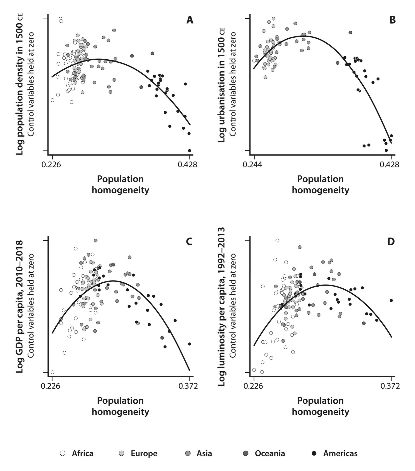
The top panels depict the impact of predicted population homogeneity on
economic development as reflected by either population density (Panel A) or
urbanization rate (Panel B). The bottom panels depict the impact of predicted
ancestry-adjusted homogeneity on economic development in the contemporary era,
as reflected by either income per capita during the 2010-18 time period (Panel
C) or luminosity per capita during the 1992–2013 time period (Panel D).
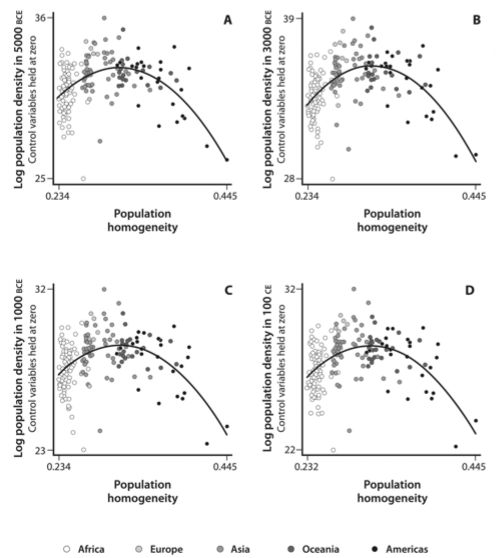
This figure depicts the impact of observed population homogeneity of
geographically indigenous ethnic groups, as predicted by migratory distance
from Africa, on long-run historical economic development, as reflected by
population density in 5000 BCE (Panel A), 3000 BCE (Panel B), 1000 BCE (Panel
C) and 100 ce (Panel D).
Furthermore, the ‘sweet spot’ level at which diversity is most
conducive for economic prosperity has increased in the past centuries. This
pattern is consistent with the hypothesis that diversity is increasingly
beneficial in the rapidly changing technological environments that have been
characteristic of advanced stages of development.[20] This growing importance
of diversity in the development process sheds new light on the causes of
China’s and Europe’s reversal of fortunes. In the year 1500 CE, the level of
diversity most conducive to development existed among nations such as Japan,
Korea, and China. Evidently, their relative homogeneity fostered social
cohesion more than it stifled innovation and was ideal in the pre-1500 era when
technological progress was slower and the benefits of diversity, therefore,
more limited. Indeed, China prospered greatly in the pre-industrial era. But as
technological progress accelerated over the subsequent five centuries, the
relative homogeneity of China appears to have delayed its transition to the
modern era of economic growth, transferring economic dominance to the more
diverse societies of Europe and subsequently North America. The level of diversity
most advantageous for economic development in the modern era is now closer to
the current level of diversity in the United States.
Human diversity is of course just one of the factors that have affected
economic fortunes, and proximity to the ‘sweet spot’ of population diversity
does not ensure prosperity. Nevertheless, accounting for geographical,
institutional, and cultural characteristics, diversity retains a considerable
effect on the economic development of countries, regions, and ethnic groups in
the present, just as in the past. The significance of these effects is
particularly extraordinary given the eons that have passed since Homo sapiens
first stepped out of Africa – and it can be quantified. About a quarter of the
unexplained variation in prosperity between nations, as reflected in average
income per capita during 2010–18, can be attributed to societal diversity. By
comparison, using the same methods, geo-climatic characteristics account for
about two-fifths of the variation, the disease environment for about
one-seventh, ethnocultural factors account for one-fifth, and political
institutions account for about one-tenth.
Yet, despite human diversity being such a powerful determinant of
prosperity, the fate of nations is not carved in stone. Quite the contrary: by
understanding the nature of that power we can design appropriate policies to
foster the benefits of diversity while mitigating its adverse effects. If
Bolivia – which has one of the least diverse populations – would foster
cultural diversity, its per capita income could increase as much as five-fold.
In contrast, if Ethiopia – one of the world’s most diverse countries – were to
adopt policies to enhance social cohesion and tolerance of difference, it could
double its current income per capita.
More generally, much could be achieved through education policies aimed
at making the best use of the levels of diversity that already exist, with
highly diverse societies seeking to promote tolerance and respect for
difference, and highly homogeneous ones encouraging openness to new ideas,
skepticism, and a willingness to challenge the status quo. In fact, any
measures that successfully enhanced pluralism, tolerance, and respect for
difference would further elevate the level of diversity that is conducive to
national productivity. And given the likelihood that technological progress
will intensify in the coming decades, the advantages of diversity in societies
that are able to foster social cohesiveness and mitigate its costs are only set
to grow.
The Grip of the Past
The impact of human diversity on economic development may be the most
striking example of how modern variations in the wealth of nations are rooted
in complex factors originating in the ancient past. In fact, readers in urban
pockets of the developed world with large migrant populations might find it
surprising that the distribution of human diversity has persisted for quite so
long across large segments of the planet. Institutional and cultural
differences between countries have diminished in the modern era, as developing
countries have tended to adopt the advantageous political and economic
institutions of developed nations, and individuals have sought to emulate
beneficial cultural norms. Likewise, some adverse effects of geography, such as
disease prevalence or lack of access to the sea, have been mitigated by
technological progress. And yet, largely due to the inherent attachment of
individuals to their homelands and their native cultures, as well as the
presence of legal barriers to international migration, human diversity in some
regions in the modern era has changed at a much slower pace.
Thus, in the absence of proper inducements – educational,
institutional, or cultural – highly diverse societies are likely to struggle to
achieve the trust and social cohesion levels needed for economic prosperity,
while homogeneous ones will fail to benefit sufficiently from the intellectual
cross-pollination on which technological and commercial progress relies. The
income gap between nations may therefore endure despite the convergence of
institutional and cultural traits across them. Such is the grip of the
past.
Since the first bands of Homo sapiens walked out of Africa millennia
ago, their societal characteristics and the distinct natural environments they
settled have been dissimilar, and the effects of those dissimilarities have
persisted over time. Some were blessed at the outset with human diversity
levels and geographical attributes that were conducive for economic
development, while others faced less favorable initial conditions that have
been detrimental to their growth process ever since. Favorable initial
conditions contributed to technological progress and led to the adoption of
growth-enhancing institutional and cultural characteristics – inclusive
political institutions, social capital, and future-oriented mindset – further
stimulating technological progress and the pace of the transition from
stagnation to growth. Unfavorable endowments, by contrast, dictated slower
trajectories, reinforced by the adoption of institutions and cultural
characteristics that hindered growth. Although throughout our history
institutions and cultures have been greatly influenced by geographic
characteristics and human diversity, they have also remained susceptible to
abrupt historical fluctuations that occasionally sway the fates of nations. As
in the case of North and South Korea, living standards may differ sharply even
between countries that share both their geography and population diversity. In these
infrequent instances, cultures and institutions could be the leading forces
behind the observed gaps across some nations.
However, the long arc of human history reveals that geographical
characteristics and population diversity, formed partly during the migration of
Homo sapiens from Africa tens of thousands of years ago, are predominantly the
deepest factors behind global inequalities, while cultural and institutional
adaptation has often dictated the speed at which development progressed in
societies across the globe. In some regions, growth-enhancing geography and
diversity led to the rapid adaptation of cultural traits and institutional
features to their surroundings, and the acceleration of technological progress.
Centuries later, this process triggered an outburst of demand for human
capital, a sudden drop in birth rates, and thus an earlier transition to the
modern era of growth. Elsewhere, this interaction set societies on a slower
journey, delaying their escape from the jaws of the Malthusian beast. Thus
emerged the extreme global disparities of the modern world.
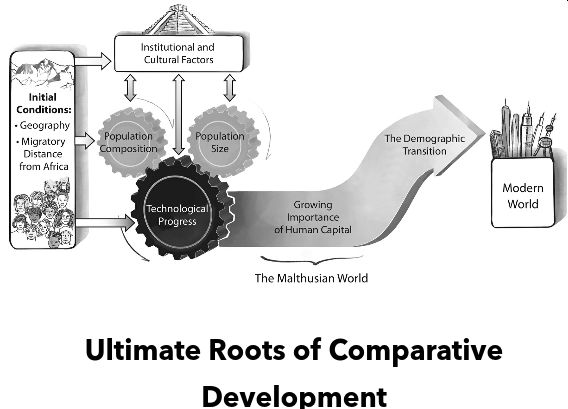
For updates click hompage here